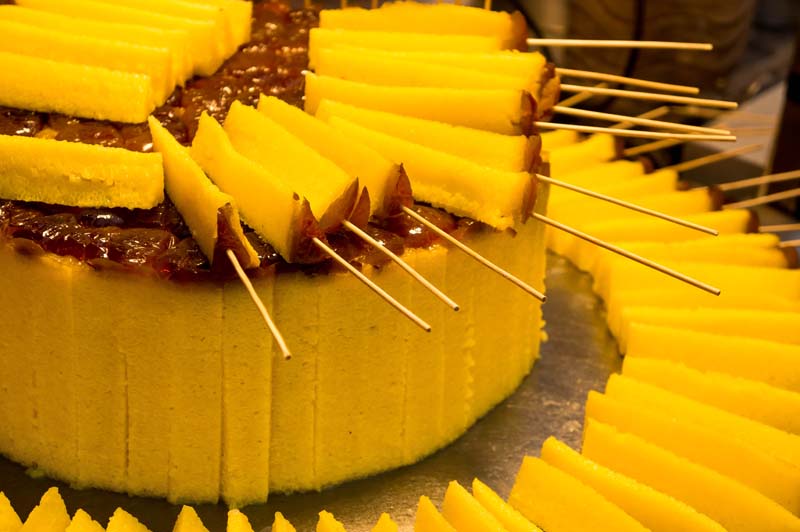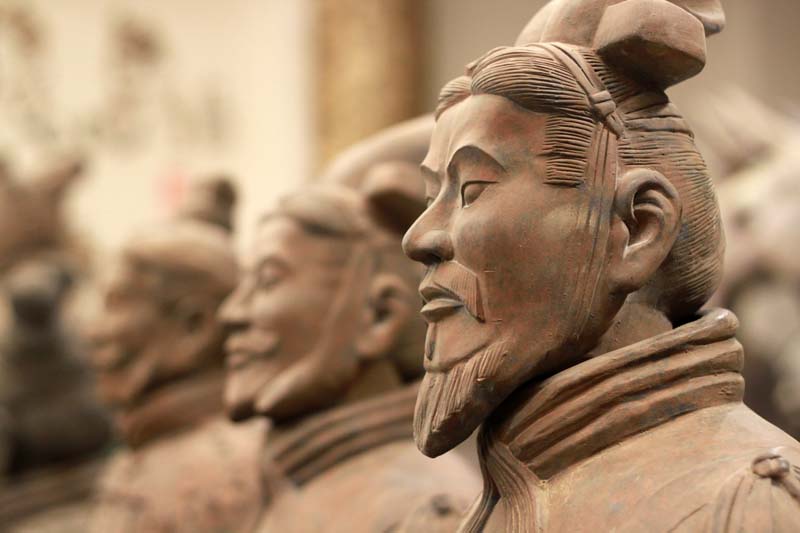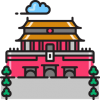
Flatbread in mutton soup (yangrou paomo)
If one dish could represent Xi’an, locals would tell you it’d be without doubt yangrou paomo — an aromatic, tasty and spicy bowl of shredded flatbread soaked in mutton broth. Eating a paomo is a uniquely relaxing exercise and here’s the right way to do it. To start with, you’ll be served two pieces of unleavened flatbread — or “mo” in Chinese — in a bowl. It’s now your job to tear the bread into pieces as small as soybeans. The process can be laborious but locals believe mo tastes much better when hand-pulled. More importantly, it’s the time for locals to sit together and trade gossip. Then, you should return the bowl and your mo crumbles will be cooked in mutton soup with rice vermicelli until the bits are fully soaked in soup and flavor. The stew will be topped with slices of lamb or beef of your choice and — like what every local would do — pickled sweet garlic is added to complete the dish.
Kabob (chuan’er)
Sharing chuan’er with friends while drinking beer late at night is a lifestyle for Xi’anese. A small skewer only costs 1 yuan ($0.16), and they’re addictive. It’s not absurd for two people to order — no kidding, it’s totally normal — 100 skewers of beef or lamb fully coated in chili pepper and cumin powder.
Xi’an meat burger (roujiamo)
It’s like a hamburger, but with a much longer history. There are just two critical elements for a roujiamo — baked leavened bread and shredded braised meat. A good jiamo should be baked using a traditional furnace instead of an electric oven. Meat — usually a mixture of fat and lean pork that has been braised for hours — should be hand-shredded and pocketed in the bread. There is also a choice for lean-meat-only pork jiamo — a little chewier than the usual ones. The best roujiamo can be found in the Muslim Quarter where the filling is either lamb or beef. How can you tell? “Their bread stays crispy for days,” says Qu Xiling, a local taxi driver. One of the recommended eateries is called WangKui Lazhi Roujiamo.Opened in 1982, it serves breads fresh off the furnace.
Biangbiang noodles
Biang is the most complex Chinese character, with 58 strokes. The word is onomatopoetic: It mimics the sound of flour dough hitting the counter when being stretched. The noodles, named one of the “10 strange wonders of Shaanxi,” are described as thick and wide as a belt (similar to pappardelle). They’re also very long — one noodle can easily fill up a whole bowl. The noodle is very savory and chewy — thanks to the eggs and oil added in the flour dough. The most common Biangbiang noodles are often served with vinegar and topped with lots of red-hot peppers, diced garlic and boiled baby bok choy. Heated oil will be added before serving. A fancier version would be topped with braised meats and assorted vegetables.

Brilliance of thousand years endows Xi’an with enchanting temperament. The continuous history of the ancient civilized capital has apparently resulted in its magnificent culture. Today’s Xi’an is a world famous tourist city and an inexhaustible treasure house of cultural relics. Now, heads of state from many countries and people from all walks of life come to the city to broaden their knowledge of Chinese civilization.

Xi’an weather is mild with four distinct seasons – a warm but variable spring, a torrid and wet summer, a cool and rainy autumn and a dry and cold winter. The annual average temperature is 13.5°C (56.3°F). The city has a moderate rainfall rate caused by the frequent summer storms and a succession of overcast and rainy days in autumn. March to May is usually warm and pleasant and is the best time of the year to pay a visit. Early autumn running through September and October is also a good time for a visit.

The urban transportation of Xian has been developed rapidly in recent years. The second ring road, third ring road and freeway-ring around the city have all been completed and put into service. The city buses and suburban buses can bring you to every corner of the city. Also, to meet the development of the tourism industry, tourist special buses and sightseeing buses are now operating. Although traffic congestion happens now and then, it is much better than that of Beijing and Shanghai. The local government also does a lot to relieve the traffic pressure, including widening roads, building pedestrian overpasses and running inter-zone buses, etc.







